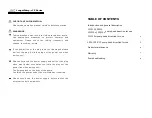
51
11.7.
A commands
Comm. Syntax
Description
AA;
AA
The AA command starts the test routine. At first all parameters
and the routine must be handled by a C-command.
AS;
AS
The AS command stops a running test.
AR;
AR
The AR command stops a running test and returns the CWS
500A to local mode.
Note: This function is only available for the RS232 interface. The
CWS 500A will answer with a string error (RR,10;<LF>) if it
receives an AR-command through the IEEE-Interface.
11.8.
Feedback messages
Message
Description
RR,00; <LF>
The test routine has been finished correctly.
RR,03; <LF>
Calibration store is not valid.
RR,04; <LF>
1. Clipping: corrected voltage is outside of limits.
Output will be set to 60.0V
2. Calibration is not in the limitations.
RR,05; <LF>
Fail signal on Fail 1
The running test will be stopped by the CWS 500A.
RR,06; <LF>
Fail signal on Fail 2. The CWS 500A continues normally but it ignores
all Fail 2 signals until it receives a C-, N- or A-command.
RR,10; <LF>
String error: there was an error in data transmission, which means too
few or too many characters, or the command is not acceptable.
RR,11; <LF>
Test start is not possible or the test has stopped because TEST ON is
not switched on.
RR,13; <LF>
No matrix selected, or wrong coupling matrix connected. The required
coupling mode can not be selected.
RR,14; <LF>
One or several values are limited by the CWS 500A. The parameters
are set to their minimum.
RR,15; <LF>
Check sum error.
RR,19; <LF>
Internal communication error. Turn off and restart the CWS 500A.
RR,20; <LF>
Non correctable limitation error.
RR,25; <LF>
The received calibration data are corrupted (Min-value or Max-value are
incorrect or Array-Nr. 265 is not set to 255.
RR, Syn; <LF>
Confirmation after all 10sec (if td > 10s) that the test is still running
normally.
RC, U; <LF>
Sends back the voltage level during calibration.
KR,
sum of Bytes
;
<LF>
Value0;<LF>
Value1;<LF>
Value2;<LF>
........
Value267;<LF>
Reads a calibration memory (see K-commands)
In the case that no feedback message is necessary, after each received string (
<
LF
>
), the two
letters of the command will be sent back.
If an error occurred, one of the three messages (RR,15;<LF> or RR,10;<LF> or RR,14;<LF>)
will be sent back.
















































